The thorny path of evolution of synthesizers: the monsters of the 50s, Moog's Voyager, the digital revolution from Chowning and Kurzweil
This is the third post in the cycle about the history of music synthesizers. Before turning to the topic, I want to thank the users for their keen interest in the articles, rich discussions and high appreciation of the publications. Thanks to timely and accurate commentary, it was possible to cover the history of almost all instruments, the invention of which predetermined the development of sound synthesis and electronic musical instruments.

The chronological period covered by this article began in the 50s of the last century and continues to the current moment. The developments and inventions of this stage gave us practically everything that we use today: samplers, digital synthesizers, dynamic key controllers, and most importantly, relatively low prices for these devices.
The first successful sampler in the world was analog and was called mellotron. Strictly speaking, the mellotron cannot be called a synthesizer in the full sense of the word. The electromechanical principle of operation of the device did not assume sound synthesis. In fact, it was a giant tape recorder that reproduced the sounds recorded on a magnetic tape, which for the time in which it appeared (early 50s) was an incredible technological breakthrough.
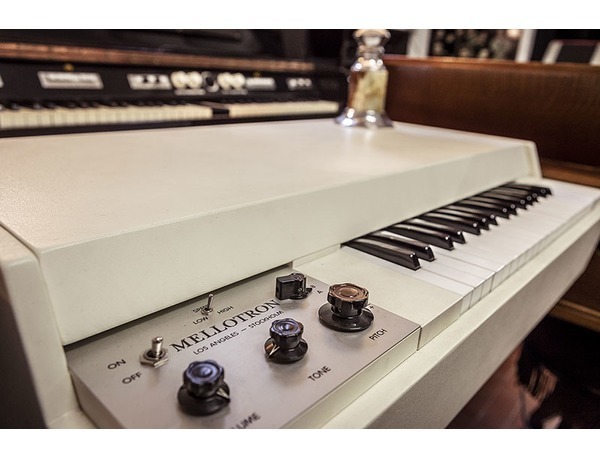
The predecessor of the mellotron, from which the latter borrowed the principle of operation, was the Chamberlin tool, developed by Harry Chamberlin in 1949. The design of Che6mberlin had a number of drawbacks, which led to the limited prevalence of the instrument. For the manufacture of a more sophisticated device, the need arose for new tape heads. Looking for a head manufacturer, one of Chamberlain’s employees, Bill Fransen, turned to British firm Bradmatic, Ltd. The owners of the company, the Bradley brothers, appreciated the musical innovation and, making improvements to the design of the first sampler, began producing the instrument under the new name - mellotron, organizing the company Mellotronics.
Promotional video "mellotron mark 2" 1965 opportunities and device design
')
In the mellotrons, each key triggered a separate tape drive mechanism, through which a magnetic tape was passed with a recording of the corresponding sound and a specific note. Pressing the key led to the playback of the tape, and releasing it started to rewind to its original position with the help of a spring mechanism. The maximum time of each mellotron sound was about 8 seconds, which led to the emergence of a special crawling spider technique, when you need to constantly change the chord reversal to prolong the sound.
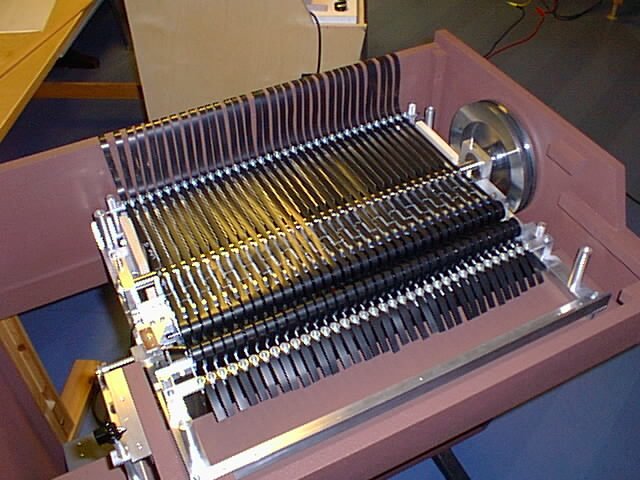
Replacing the ribbon cartridge on Mellotron Mk VI
Mellotrons are one of the most enduring devices of their time. They created a serious competition for the first digital samplers, since the latter did not have enough memory. These tools held out on the market until the end of the 80s, when their advanced digital counterparts began to gradually occupy their niche.
Interestingly, the first commercial versions of the device were called Mellotron Mark I and Mark II, which is why there is a serious confusion in historiography. In particular, in Wikipedia, in an article describing the history of synthesizers, the legendary RCA device - Mark I is mentioned, with a reference to a Russian-language article on the mellotron. The error is more than significant, since the devices are fundamentally different and in no way connected with each other.
The first musical synthesizers , in the modern sense of the word, were RCA Mark I and Mark II. The creation of the firstborn involved engineers RCA Princeton Laboratory Company Harry Olson and Herbert Belar. It was these people who tied together the laws of the fundamental theory of information transfer, formulated by cryptographer Claude Shannon, and the experience of their predecessors, who developed analogue electromusical devices.
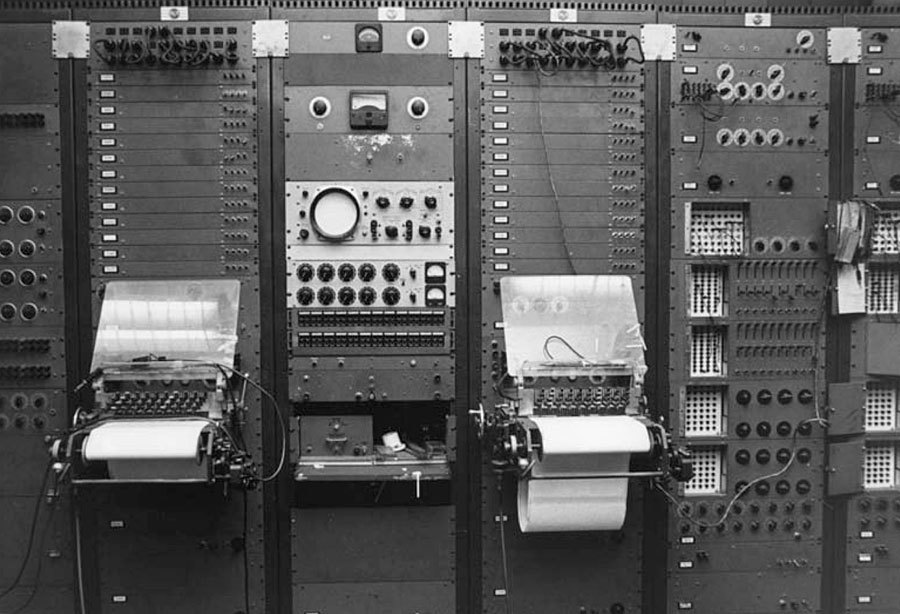
As a theoretical basis for creating the device in 1950, a work was published by scientists called “Preliminary studies of modern communication theory as applied to musical sound recordings”, which for the first time proposed principles for using mathematical methods to create music and musical equipment. The first prototype of the device, based on these principles, was created back in 1951, and on January 31, 1955, the inventors presented the first full-fledged RCA Mark I synthesizer and a demo record with instrument recordings.
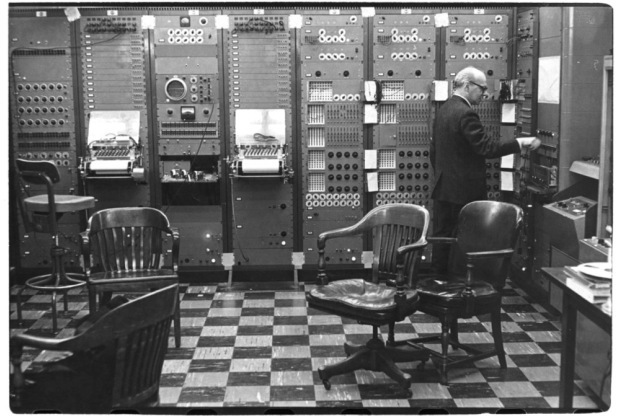
Like the computers of those years, Mark I occupied a whole room. For the synthesis, 12 lamp oscillators, a modulation device, an infinite number of frequency filters, resonators, etc. were used. As a memory device, the musical "monster" used roll punched tape, to which settings were recorded when extracting a sound. The most tangible drawbacks of the device, with all the revolutionary principle, were the difficulties with imitating smooth transitions from one note to another, which are characteristic of a string and wind instrument. Otherwise, for the time in which it was created, the Mark 1 was a technically flawless device.
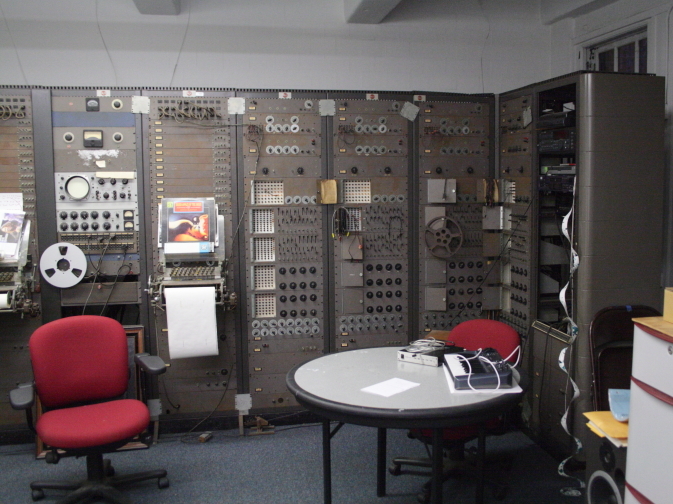
Almost immediately after Mark I, in 1959, RCA released the Mark II, both devices remain piece, experimental, and cost insane, at that time, about $ 175,000. The RCA sound recording unit refuses to use synthesizers to avoid likely conflicts with performers and unions of musicians. Despite the exorbitant cost, both devices have commercial success. Mark I is sent to study the possibilities of sound and music synthesis at the Smithsonian Institution, and Mark II, at the expense of the Rockefeller Foundation, buys the Columbia Princeton Center for Electronic Music.
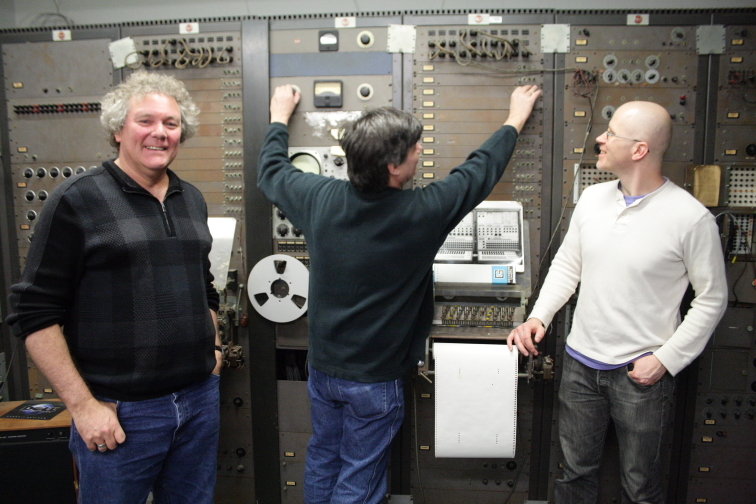
The most famous and recognized work, created on RCA Mark II, was Charles Warinen's album “Time Enconium”, recorded in 1968.
I recommend to listen only for familiarization with the possibilities of the synthesizer, extremely tough avant-garde
In addition, the synthesizer was actively used by composers to create music: Vladimir Usachevsky, Otto Lyuning, Milton Babbitt, Mario Davidovsky. Surprisingly, Mark II works to this day and is located in the New York Computer Music Center.

RCA Mark II Synthesizer, Milton Babbitt, Peter Mosey, Vladimir Usachevsky, 1958
Behind inventions are always people. The conceptual breakthrough of Robert Moog, which allowed to make the synthesizer practically accessible to all, confirms this. The efforts of this successful inventor and businessman gave us the opportunity to buy a synthesizer, as an expensive, but quite feasible toy. Moog changed ideas about these devices, which were perceived as experimental piece giant "cabinets" for a limited elite circle of selected composers and researchers. In many ways, thanks to Moog, the synthesizer has become a mass product and is now available to everyone.
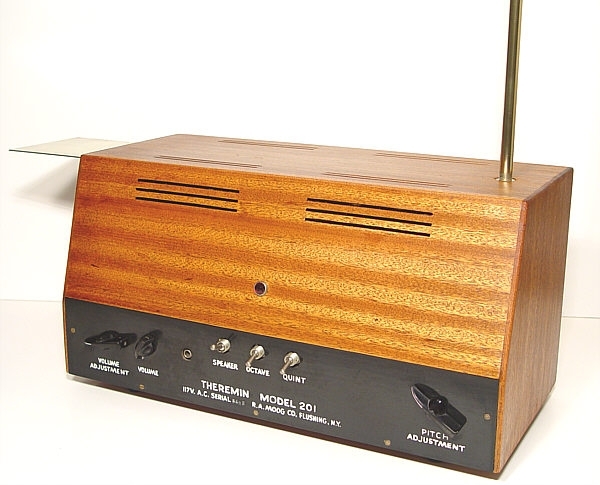
Theremin Moog, model 200
While still a teenager, in 1953, Robert (Bob) Moog, together with his father (an engineer at Consolidated Edison), designed and produced his own version of theremin. Having published an article about this in one of the radio magazines, he unexpectedly received a lot of letters with orders for the production of the Theremen tool. Already as a student, Moog was able to improve the design and began the artisanal mass production of transistor the theremins, in the form of the DIY designer for radio amateurs. The experience was successful, and Moog quickly became a very rich man.
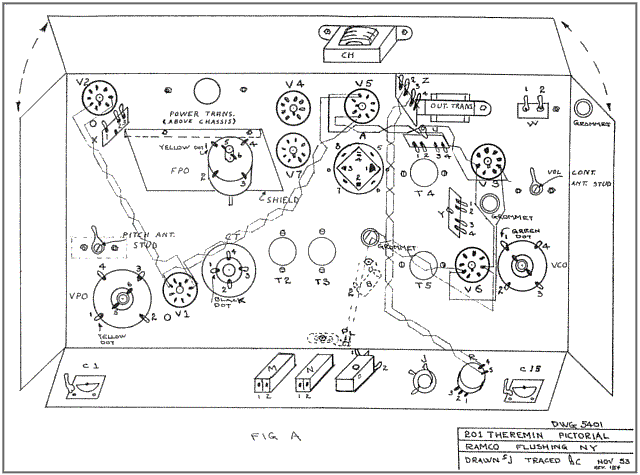
Theremin Model Scheme 201, November 1953
In 1963, at a conference in the New York State School Music, Moog met the musical experimenter Herbert Deutsch. As a result of creative interaction between the inventor and the composer, the idea of a transistor, monophonic, keyboardless, budget synthesizer, created on the basis of the doorbell, is born.
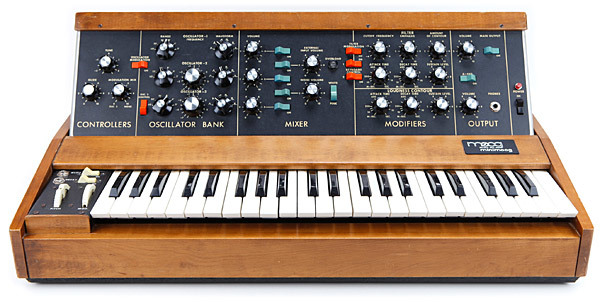
By the end of the 60s, Moog was launching the release of keyboard modular synthesizers , developed on the basis of Harald Bode’s ideas. Mooga Synthesizers use new original principles of circuit control using the same voltages, also developed by Bode.
With the development of technology and the active use of semiconductors, synthesizers are rapidly becoming cheaper, their capabilities are expanding, and the sizes are becoming smaller. In 1970, Moog and his engineers designed the first portable synthesizer Minimoog, which instantly gains popularity. A small monophonic device gives quite ample opportunities at a cost that is several times lower than the majority of similar in size and more dimensional instruments.
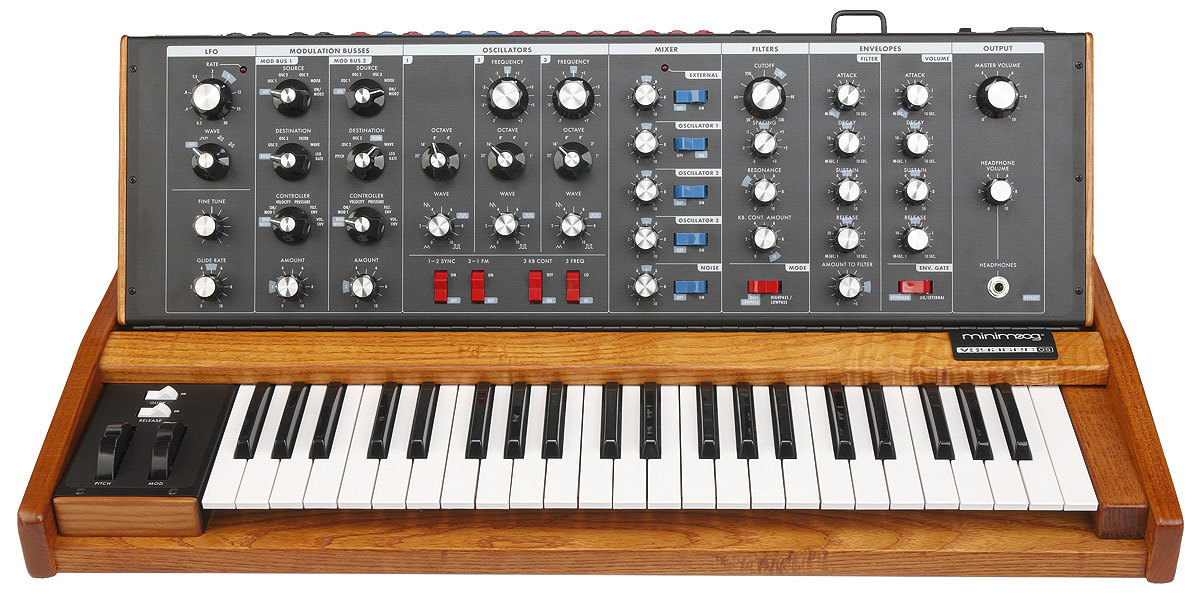
Every 3 years, the Mooga company releases a landmark device that becomes a kind of benchmark for world-class analog synthesization, such as the legendary Moog Voyager. Moog is also credited with creating the first synthesizer with a dynamic keyboard.
In fairness, it should be noted that such devices appeared before him, both in the United States and in the USSR. The primacy, most likely, belongs to the synthesizer "Ekvodin-9", the principles of the dynamic keyboard which were developed back in the 30s.

Moog synthesizers are produced to this day, not infrequently repeating the functionality of the predecessors from the 70s. In the above video a comparison of the sound and capabilities of the old Minimoog Model D and the modern Voyager:
Ray Kurzweil - the inventor, futurist, one of the prominent ideologists of the computer business, is rightfully considered one of the creators of the digital synthesizer. In 1982, Kurzweil, inspired by Stevie Wander, opens the company - Kurzweil Music Systems (KMS), which for 2 years almost from scratch creates a unique for its time, the world's first digital sample synthesizer Kurzweil 250.
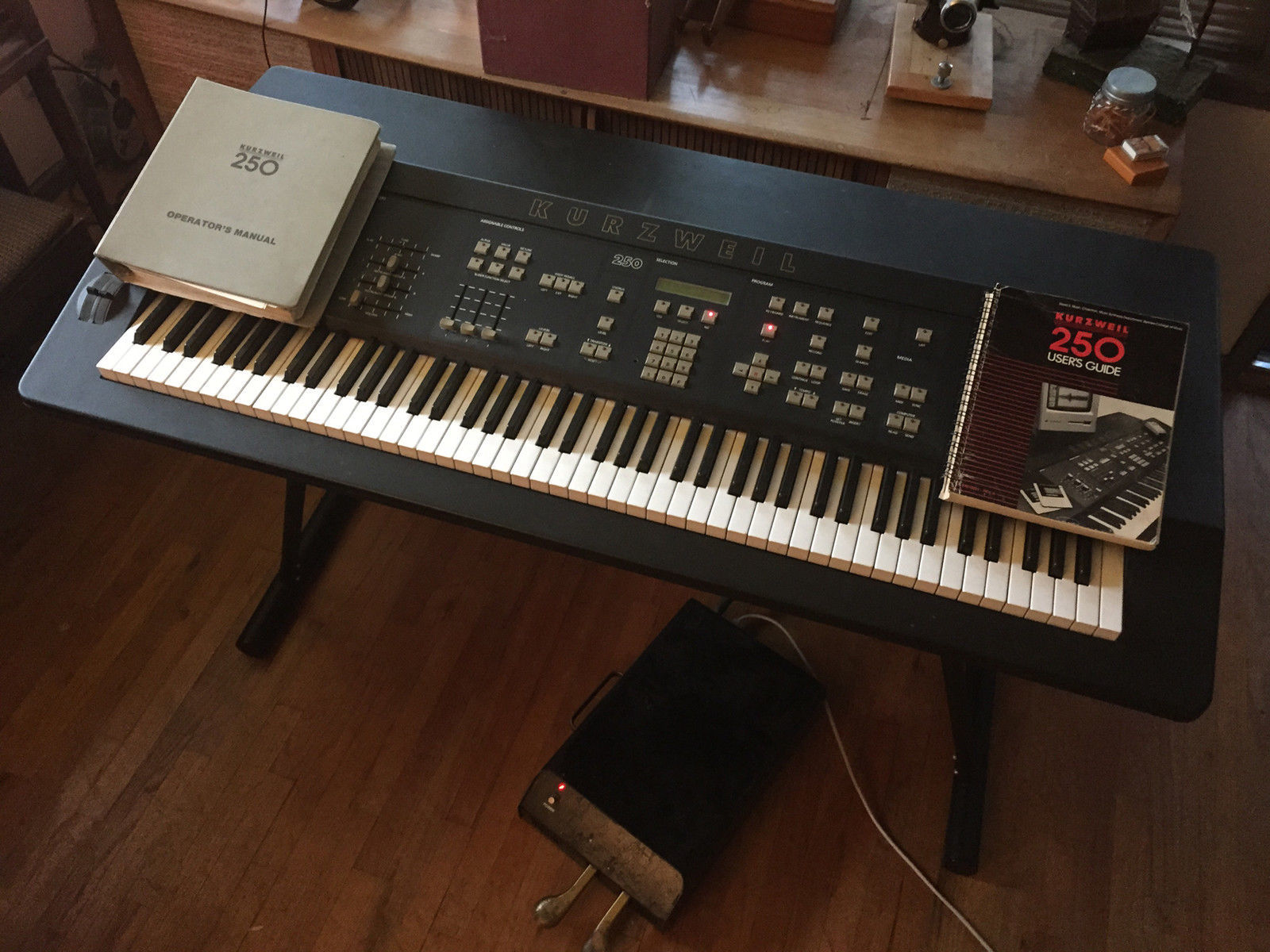
By the way, the hero of the previous section, Robert Moog, also made quite a few efforts to create a digital sampler, working in the Kurzweil team.
The device was a music computer with a standalone OS (the system is updated to this day).

Serial samples of the K250 were stored in memory and reproduced digitized fragments of the sounds of living instruments. The keyboard of the device, in terms of speed of response and sensitivity of the dynamics exceeded all the analogs existing at that moment.
The blind tests conducted showed that professional pianists could not distinguish the sound of the K250 from the sound of a concert grand piano. The architecture of the K250 hit its contemporaries, in fact, the device was implemented tunable digital signal processor (DSP), which controlled the parameters of the virtual sound path. Kurzweil himself was proud of the social capabilities of the synthesizer, which allowed blind children to study and play music. The cost of acoustic instruments in the USA in the 1980s was excessively high, and its synthesizer became the solution.
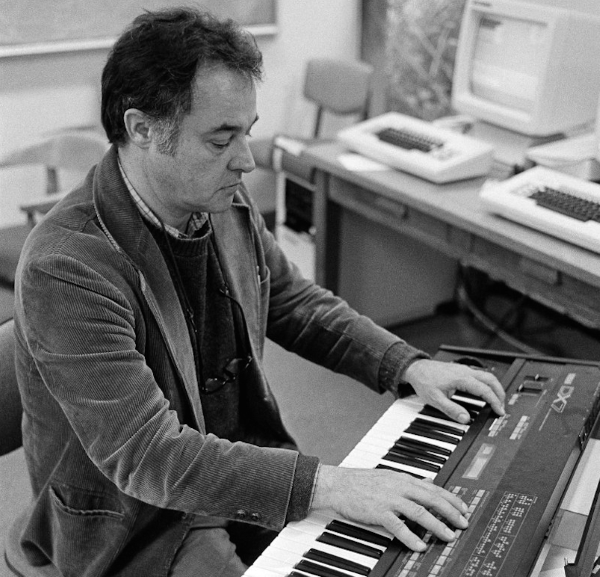
John chowning
A great contribution to the development of digital synthesizers was made by John Chowning, who is rightly considered to be their “father”. Unlike Kurzweil, who used digitized recorded samples, Chowning became the pioneer of self-digital synthesis. The principles of digital FM sound synthesis were patented by Chowning back in 1974.
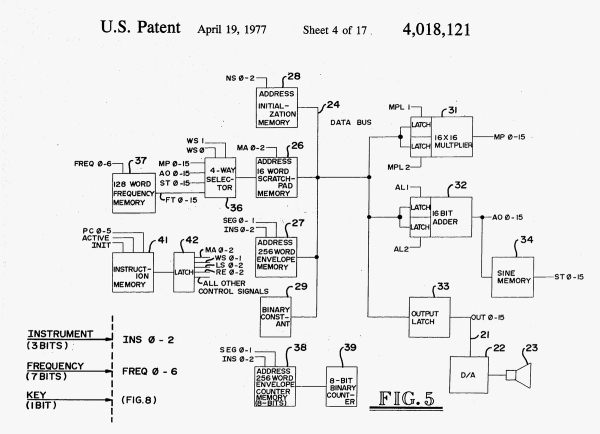
One of the 17 schemes attached to the patent application for FM synthesis filed by Chowning in 1974
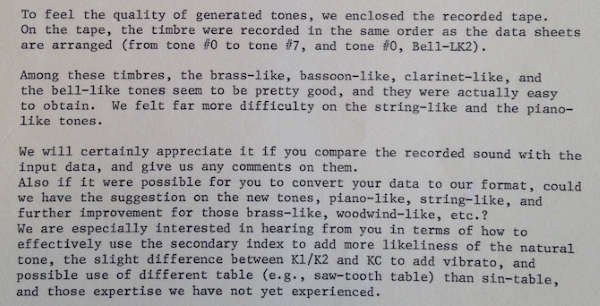
Note on the progress of Yamaha employees in digital sound synthesis (Special Collection of the Stanford Library)
In the same 1974, the first prototype appeared, a device called MAD, developed by YAMAHA using Chowning technology, in 1974. By 1983, together with Yamaha, it was possible to create the first production tool, which was the Yamaha DX-7.
Thus, Chowning, on the one hand, and Kurzweil, on the other, predetermined the development of synthesizers to the present, when samples based on neural networks appeared and improved.
The following material in this cycle will be the last and will bring together the most advanced developments in the field of sound synthesis.

The chronological period covered by this article began in the 50s of the last century and continues to the current moment. The developments and inventions of this stage gave us practically everything that we use today: samplers, digital synthesizers, dynamic key controllers, and most importantly, relatively low prices for these devices.
First samplers
The first successful sampler in the world was analog and was called mellotron. Strictly speaking, the mellotron cannot be called a synthesizer in the full sense of the word. The electromechanical principle of operation of the device did not assume sound synthesis. In fact, it was a giant tape recorder that reproduced the sounds recorded on a magnetic tape, which for the time in which it appeared (early 50s) was an incredible technological breakthrough.

The predecessor of the mellotron, from which the latter borrowed the principle of operation, was the Chamberlin tool, developed by Harry Chamberlin in 1949. The design of Che6mberlin had a number of drawbacks, which led to the limited prevalence of the instrument. For the manufacture of a more sophisticated device, the need arose for new tape heads. Looking for a head manufacturer, one of Chamberlain’s employees, Bill Fransen, turned to British firm Bradmatic, Ltd. The owners of the company, the Bradley brothers, appreciated the musical innovation and, making improvements to the design of the first sampler, began producing the instrument under the new name - mellotron, organizing the company Mellotronics.
Promotional video "mellotron mark 2" 1965 opportunities and device design
')
In the mellotrons, each key triggered a separate tape drive mechanism, through which a magnetic tape was passed with a recording of the corresponding sound and a specific note. Pressing the key led to the playback of the tape, and releasing it started to rewind to its original position with the help of a spring mechanism. The maximum time of each mellotron sound was about 8 seconds, which led to the emergence of a special crawling spider technique, when you need to constantly change the chord reversal to prolong the sound.

Replacing the ribbon cartridge on Mellotron Mk VI
Mellotrons are one of the most enduring devices of their time. They created a serious competition for the first digital samplers, since the latter did not have enough memory. These tools held out on the market until the end of the 80s, when their advanced digital counterparts began to gradually occupy their niche.
Mellotrons were used and are still used by legendary rock musicians, including:
The Beatles ("Strawberry Fields Forever" and others), The Moody Blues ("Love and Beauty"), Led Zeppelin - ("The Rain Song"), King Crimson (albums "Epitaph", "In The Court of the Crimson King ”,“ Starless ”), Genesis, Tom Waits, The Rolling Stones, Nine Inch Nails, Marilyn Manson.
Interestingly, the first commercial versions of the device were called Mellotron Mark I and Mark II, which is why there is a serious confusion in historiography. In particular, in Wikipedia, in an article describing the history of synthesizers, the legendary RCA device - Mark I is mentioned, with a reference to a Russian-language article on the mellotron. The error is more than significant, since the devices are fundamentally different and in no way connected with each other.
Reference Point - RCA - Mark I and Mark II
The first musical synthesizers , in the modern sense of the word, were RCA Mark I and Mark II. The creation of the firstborn involved engineers RCA Princeton Laboratory Company Harry Olson and Herbert Belar. It was these people who tied together the laws of the fundamental theory of information transfer, formulated by cryptographer Claude Shannon, and the experience of their predecessors, who developed analogue electromusical devices.

As a theoretical basis for creating the device in 1950, a work was published by scientists called “Preliminary studies of modern communication theory as applied to musical sound recordings”, which for the first time proposed principles for using mathematical methods to create music and musical equipment. The first prototype of the device, based on these principles, was created back in 1951, and on January 31, 1955, the inventors presented the first full-fledged RCA Mark I synthesizer and a demo record with instrument recordings.

Like the computers of those years, Mark I occupied a whole room. For the synthesis, 12 lamp oscillators, a modulation device, an infinite number of frequency filters, resonators, etc. were used. As a memory device, the musical "monster" used roll punched tape, to which settings were recorded when extracting a sound. The most tangible drawbacks of the device, with all the revolutionary principle, were the difficulties with imitating smooth transitions from one note to another, which are characteristic of a string and wind instrument. Otherwise, for the time in which it was created, the Mark 1 was a technically flawless device.
Almost immediately after Mark I, in 1959, RCA released the Mark II, both devices remain piece, experimental, and cost insane, at that time, about $ 175,000. The RCA sound recording unit refuses to use synthesizers to avoid likely conflicts with performers and unions of musicians. Despite the exorbitant cost, both devices have commercial success. Mark I is sent to study the possibilities of sound and music synthesis at the Smithsonian Institution, and Mark II, at the expense of the Rockefeller Foundation, buys the Columbia Princeton Center for Electronic Music.
The most famous and recognized work, created on RCA Mark II, was Charles Warinen's album “Time Enconium”, recorded in 1968.
I recommend to listen only for familiarization with the possibilities of the synthesizer, extremely tough avant-garde
In addition, the synthesizer was actively used by composers to create music: Vladimir Usachevsky, Otto Lyuning, Milton Babbitt, Mario Davidovsky. Surprisingly, Mark II works to this day and is located in the New York Computer Music Center.

RCA Mark II Synthesizer, Milton Babbitt, Peter Mosey, Vladimir Usachevsky, 1958
How the global brand started with a doorbell and DIY-theremin
Behind inventions are always people. The conceptual breakthrough of Robert Moog, which allowed to make the synthesizer practically accessible to all, confirms this. The efforts of this successful inventor and businessman gave us the opportunity to buy a synthesizer, as an expensive, but quite feasible toy. Moog changed ideas about these devices, which were perceived as experimental piece giant "cabinets" for a limited elite circle of selected composers and researchers. In many ways, thanks to Moog, the synthesizer has become a mass product and is now available to everyone.

Theremin Moog, model 200
While still a teenager, in 1953, Robert (Bob) Moog, together with his father (an engineer at Consolidated Edison), designed and produced his own version of theremin. Having published an article about this in one of the radio magazines, he unexpectedly received a lot of letters with orders for the production of the Theremen tool. Already as a student, Moog was able to improve the design and began the artisanal mass production of transistor the theremins, in the form of the DIY designer for radio amateurs. The experience was successful, and Moog quickly became a very rich man.

Theremin Model Scheme 201, November 1953
In 1963, at a conference in the New York State School Music, Moog met the musical experimenter Herbert Deutsch. As a result of creative interaction between the inventor and the composer, the idea of a transistor, monophonic, keyboardless, budget synthesizer, created on the basis of the doorbell, is born.

By the end of the 60s, Moog was launching the release of keyboard modular synthesizers , developed on the basis of Harald Bode’s ideas. Mooga Synthesizers use new original principles of circuit control using the same voltages, also developed by Bode.
With the development of technology and the active use of semiconductors, synthesizers are rapidly becoming cheaper, their capabilities are expanding, and the sizes are becoming smaller. In 1970, Moog and his engineers designed the first portable synthesizer Minimoog, which instantly gains popularity. A small monophonic device gives quite ample opportunities at a cost that is several times lower than the majority of similar in size and more dimensional instruments.

Every 3 years, the Mooga company releases a landmark device that becomes a kind of benchmark for world-class analog synthesization, such as the legendary Moog Voyager. Moog is also credited with creating the first synthesizer with a dynamic keyboard.
In fairness, it should be noted that such devices appeared before him, both in the United States and in the USSR. The primacy, most likely, belongs to the synthesizer "Ekvodin-9", the principles of the dynamic keyboard which were developed back in the 30s.

Moog synthesizers are produced to this day, not infrequently repeating the functionality of the predecessors from the 70s. In the above video a comparison of the sound and capabilities of the old Minimoog Model D and the modern Voyager:
Gigantic steps in the "figure": the contribution of Chowning and Kurzweil
Ray Kurzweil - the inventor, futurist, one of the prominent ideologists of the computer business, is rightfully considered one of the creators of the digital synthesizer. In 1982, Kurzweil, inspired by Stevie Wander, opens the company - Kurzweil Music Systems (KMS), which for 2 years almost from scratch creates a unique for its time, the world's first digital sample synthesizer Kurzweil 250.

By the way, the hero of the previous section, Robert Moog, also made quite a few efforts to create a digital sampler, working in the Kurzweil team.
The device was a music computer with a standalone OS (the system is updated to this day).

Serial samples of the K250 were stored in memory and reproduced digitized fragments of the sounds of living instruments. The keyboard of the device, in terms of speed of response and sensitivity of the dynamics exceeded all the analogs existing at that moment.
The blind tests conducted showed that professional pianists could not distinguish the sound of the K250 from the sound of a concert grand piano. The architecture of the K250 hit its contemporaries, in fact, the device was implemented tunable digital signal processor (DSP), which controlled the parameters of the virtual sound path. Kurzweil himself was proud of the social capabilities of the synthesizer, which allowed blind children to study and play music. The cost of acoustic instruments in the USA in the 1980s was excessively high, and its synthesizer became the solution.

John chowning
A great contribution to the development of digital synthesizers was made by John Chowning, who is rightly considered to be their “father”. Unlike Kurzweil, who used digitized recorded samples, Chowning became the pioneer of self-digital synthesis. The principles of digital FM sound synthesis were patented by Chowning back in 1974.

One of the 17 schemes attached to the patent application for FM synthesis filed by Chowning in 1974

Note on the progress of Yamaha employees in digital sound synthesis (Special Collection of the Stanford Library)
In the same 1974, the first prototype appeared, a device called MAD, developed by YAMAHA using Chowning technology, in 1974. By 1983, together with Yamaha, it was possible to create the first production tool, which was the Yamaha DX-7.
Thus, Chowning, on the one hand, and Kurzweil, on the other, predetermined the development of synthesizers to the present, when samples based on neural networks appeared and improved.
The following material in this cycle will be the last and will bring together the most advanced developments in the field of sound synthesis.
Source: https://habr.com/ru/post/400761/
All Articles